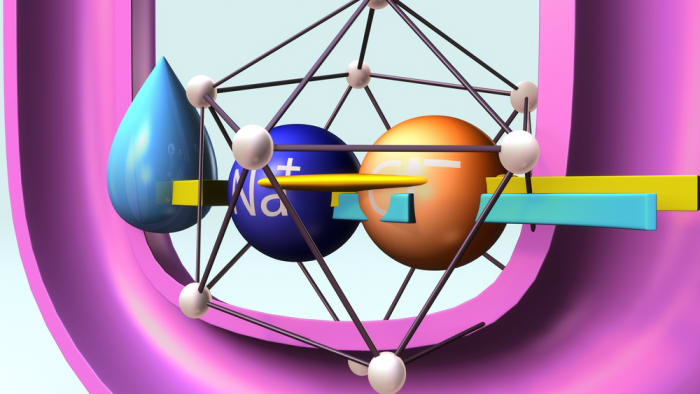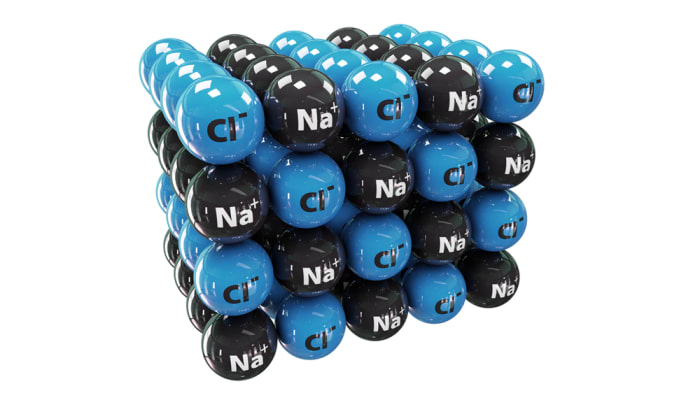The reaction of sodium chloride
Chemical properties of table salt

Sodium chloride or sodium salt of hydrochloric acid is a powder or crystals of a colorless, odorless substance, with a salty taste. In everyday life, sodium chloride is known as table salt. The chemical formula is NaCl. In nature it is encountered in the form of halite, i.e. rock salt. Pure sodium chloride is colorless, but if it contains impurities, it may take on other colors. For example, it may be purple or blue, yellow or pink.
Physical properties of sodium chloride
It is moderately soluble in water, and the temperature at which the reaction takes place plays practically no role. At a temperature of 21 °C the coefficient of solubility in 100g of water is 35.9, at 100 C it is 38.1 Chloride ions form a cubic lattice, with sodium ions are at the top. Melting point is 800.8 °C. Table salt begins to boil at a temperature of 1,465 °C.
Chemical properties of the sodium salt of hydrochloric acid
NaCl is a salt which was formed as a result of the interaction of an alkali and acid. Sodium chloride is a strong electrolyte. The ions attract each other very strongly, and the attraction between them can only be broken by polar solvents. In H₂O the crystal lattice easily falls apart. Anions and cations of the bond are freed (Na⁺, Cl⁻). This explains the good electrical conductivity of sodium chloride.

Qualitative reactions to sodium cations
The qualitative reaction to determine the sodium cation Na⁺
Take a wire and make a loop at the end of it. Put a little salt on the loop and hold it up to a flame. The flame will burn with a yellow color – this shows the presence of sodium.
Another reaction for the sodium cation
Dioxouranium(VI) zinc acetate forms a yellow crystalline sediment. The chemical reaction is:
NaCl + Zn(UO₂)₃(CH₃COO)₈ + CH₃COOH + 9H₂O ↔ NaZn(UO₂)₃(CH₃COO)₉ · 9H₂O↓ + HCl
Reaction of potassium hexahydroxoantimonate(V)
A white sediment forms, which is soluble in alkalis:
NaCl + K[Sb(OH)₆] ↔ Na[Sb(OH)₆]↓ + KCl
In an acid medium, the reagent breaks down with the formation of a white amorphous sediment of meta-antimonic acid HSbO₃:
K[Sb(OH)₆] +HCl ↔ KCl + H₃SbO₄ + 2H₂O
H₃SbO₄ ↔ HSbO₃↓ + H₂O
Qualitative reaction to the presence of an anion, i.e. Cl⁻
This can be observed in the qualitative reaction to chloride ions. In the interaction with silver nitrate, a sediment of silver chloride of a white color forms. The chemical formula is:
AgNO₃ + NaCl = AgCl + NaNO₃

Hydrogen chloride from the salt is forced out by stronger acids than hydrochloric acid. The chemical reaction is:
2NaCl + H₂SO₄ = Na₂SO₄ + 2HCl
Quantitative determination of sodium chloride
We take a standard solution of sodium chloride and pour it into a flask, dilute it with two parts distilled water, add two drops of potassium chromate solution and titrate with a solution of silver nitrate until an orange-yellow color appears:
NaCl + AgNO₃ → AgCl↓ + NaNO₃

Another method for the reaction of sodium chloride and determining the quantity of salt. Mix a sodium chloride solution in a flask for titration, add 4 drops of diluted nitric acid (1:4), 4 drops of a saturated alcohol solution of diphenylcarbazone. Start to titrate with a 0.01 M solution of mercury perchlorate until a pinkish-purple color appears.
Click here to see more experiments with sodium chloride.
Location of table salt
There is a sufficient quantity of sodium chloride on Earth. It can be found:
- In the water of seas, oceans and lakes. The world ocean contains 120 billion tons of sodium chloride. 1.3 tons of sodium chloride can be obtained for 1,000 tons of sea water.
- There are many deposits of this mineral in various countries, and the largest deposit can be found in Great Britain.
- On the shores of salt lakes.
- In salt marshes
- On the walls of volcano craters.
Use and benefit of salt for human beings
Kitchen salt is used for salting vegetables, fish and meat. It is used as antiseptic.

The role of sodium chloride is also important in medicine; it is used for an isotonic solution. 9 g of salt is diluted in 1 liter of water. This is the concentration of chloride solution found in the human body: in liquid and tissues. Solutions with higher concentrations are used as antimicrobial agents, and also to prevent rotting and fermentation.
Despite its many positive characteristics, in large amounts salt is very harmful and poisonous for chickens, dogs and cats. Humans are also not recommended to consume a lot of salt, as this may cause tissue swelling.